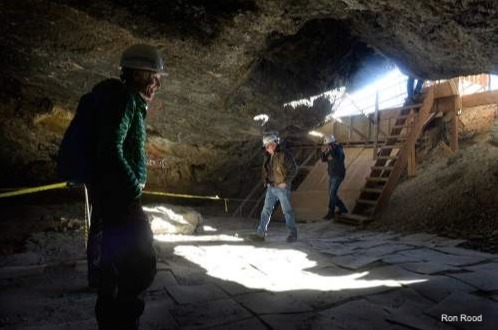Dublin Core
Title
Description
Formed under the waves of ancient Lake Bonneville over 10,000 years ago, Danger Cave was home to members of the Desert Archaic culture. Located in present-day Tooele County at the edge of the Bonneville Salt Flats, Danger Cave is considered to be among the Great Basin’s most important prehistoric human sites. But the cave’s contents reveal more than just the history of its inhabitants -- they also hold clues to Utah’s water future.
The mid-twentieth century excavation of Danger Cave by University of Utah archaeologist Jesse Jennings expanded Western knowledge about the many groups of Indigenous peoples who lived in the Great Basin region. According to research made during excavations, the ancient peoples of Danger Cave lived relatively well, but were challenged by the arid climate. Caves provided adequate shelter near a lakeside view with access to plants, small game, and freshwater fish in the marshlands. Over time, the cave was inhabited by many different groups of Native peoples who left behind layers of artifacts for archaeologists to uncover.
However, it’s not just human history found in prehistoric caves. Stalagmites are mineral deposits formed by dripping water that offer a readable record -- like rings on a tree. Using chemistry, scientists date the layers of build-up and measure the concentration of naturally-occurring uranium in stalagmites. This process determines their age and the implications of climate on their development. Stalagmites in Leviathan Cave -- near Danger Cave -- reveal that ancient peoples suffered a period of drought lasting nearly 4,000 years. Over time, the region’s land of plenty became history. Plagued by years of heat and drought, ancient peoples watched their fresh water source dry up. They were forced to adapt to new foodways and change their annual gathering and hunting routines.
Scientists anticipate humans today will confront long periods of drought due to climate change. As Utah endures hotter, drier seasons, scientists warn that we might face a similarly dramatic shift in climate that threatens our lifestyle. The paleoclimate data found in caves like Leviathan and Danger Cave show us what nature is capable of, and Danger Cave tells the story of a prehistoric community upended by extended periods of heat and drought that swept across the Southwest.
Creator
Source
_______________
See Metcalf Archaeological Consultants, “Danger Cave State Monument” (take a guided tour); Judy Fahys, “Why a Utah Cave May Hold Clues to Climate Change and a Warning About Our Water Future,” Salt Lake Tribune, November 30, 2020; United States Department of Interior, National Park Service, “National Register of Historic Places: Danger Cave,” October 1984; Ashley Olson, “Danger Cave,” Intermountain Histories, January 16, 2018; “Danger Cave Near Wendover Provided Clues to Ancient Utah Dwellers,” Utah History Blazer (June 1995); Tom Wharton, “Utah’s Little Known Danger Cave,” Salt Lake Tribune, May 9, 2011.

